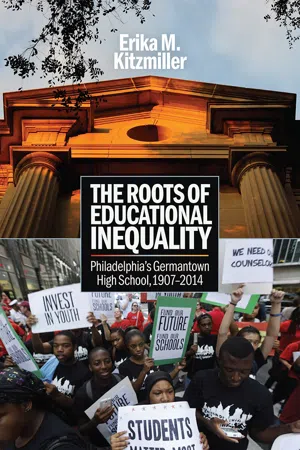
The Roots of Educational Inequality
Philadelphia's Germantown High School, 1907-2014
- 352 pages
- English
- ePUB (mobile friendly)
- Available on iOS & Android
The Roots of Educational Inequality
Philadelphia's Germantown High School, 1907-2014
About this book
The Roots of Educational Inequality chronicles the transformation of one American high school over the course of the twentieth century to explore the larger political, economic, and social factors that have contributed to the escalation of educational inequality in modern America.In 1914, when Germantown High School officially opened, Martin G. Brumbaugh, the superintendent of the School District of Philadelphia, told residents that they had one of the finest high schools in the nation. Located in a suburban neighborhood in Philadelphia's northwest corner, the school provided Germantown youth with a first-rate education and the necessary credentials to secure a prosperous future. In 2013, almost a century later, William Hite, the city's superintendent, announced that Germantown High was one of thirty-seven schools slated for closure due to low academic achievement. How is it that the school, like so many others that serve low-income students of color, transformed in this way?Erika M. Kitzmiller links the saga of a single high school to the history of its local community, its city, and the nation. Through a fresh, longitudinal examination that combines deep archival research and spatial analysis, Kitzmiller challenges conventional declension narratives that suggest American high schools have moved steadily from pillars of success to institutions of failures. Instead, this work demonstrates that educational inequality has been embedded in our nation's urban high schools since their founding. The book argues that urban schools were never funded adequately. Since the beginning of the twentieth century, urban school districts lacked the tax revenues needed to operate their schools. Rather than raising taxes, these school districts relied on private philanthropy from families and communities to subsidize a lack of government aid. Over time, this philanthropy disappeared leaving urban schools with inadequate funds and exacerbating the level of educational inequality.
Frequently asked questions
- Essential is ideal for learners and professionals who enjoy exploring a wide range of subjects. Access the Essential Library with 800,000+ trusted titles and best-sellers across business, personal growth, and the humanities. Includes unlimited reading time and Standard Read Aloud voice.
- Complete: Perfect for advanced learners and researchers needing full, unrestricted access. Unlock 1.4M+ books across hundreds of subjects, including academic and specialized titles. The Complete Plan also includes advanced features like Premium Read Aloud and Research Assistant.
Please note we cannot support devices running on iOS 13 and Android 7 or earlier. Learn more about using the app.
Information
Table of contents
- Cover Page
- Title Page
- Copyright
- Dedication
- Contents
- Prologue
- Introduction
- Chapter 1. The Campaign for an Elite Public High School in Philadelphia’s Suburban Sanctuary, 1907–1914
- Chapter 2. Philanthropy Sustains Philadelphia’s Expanding Public School System, 1914–1920
- Chapter 3. Philadelphia’s Reliance on Philanthropy Begins to Crack, 1929–1940
- Chapter 4. Philadelphia Mobilizes for War, Inequality on the Homefront Escalates, 1941–1957
- Chapter 5. Urban Renewal, Urban Unrest, and the Threat of a “Poverty-Stricken Negro Ghetto,” 1958–1967
- Chapter 6. The Emergence of an “Urban” School System: Fiscal Shortages, Labor Strikes, and Stalled Desegregation, 1968–1981
- Chapter 7. Philadelphia School Leaders Fight to Restore and Control Philadelphia’s Public Schools, 1982–2000
- Chapter 8. Philadelphia Implements the “Largest and Boldest Experiment” in Urban Public Education, 2002–2011
- Chapter 9. School Officials Close Schools to “Save” Philadelphia’s Public School System
- Appendix
- Notes
- Bibliography
- Acknowledgments